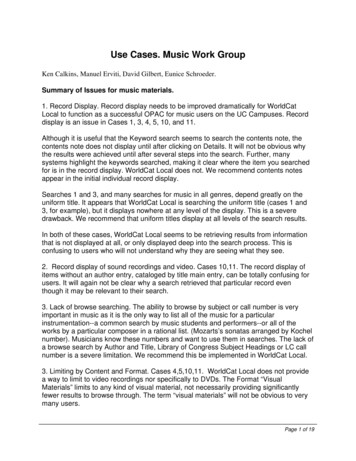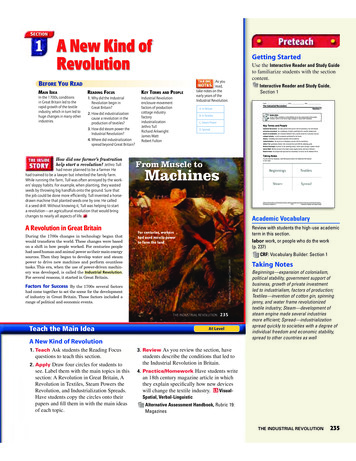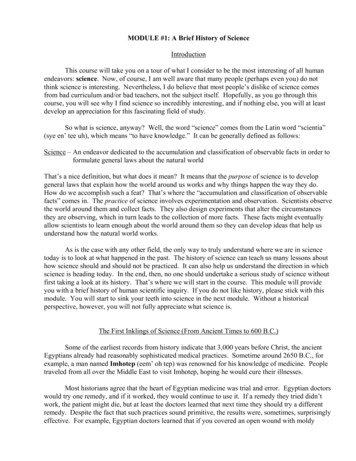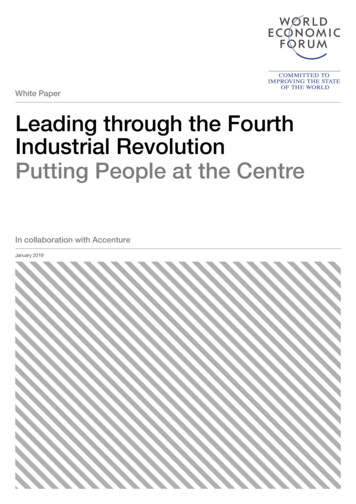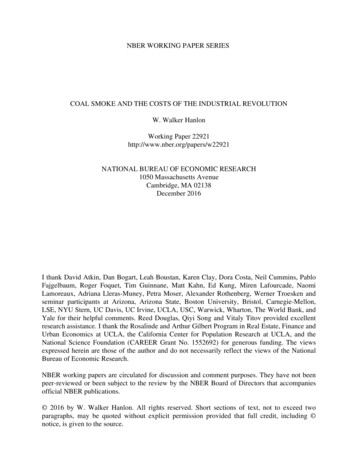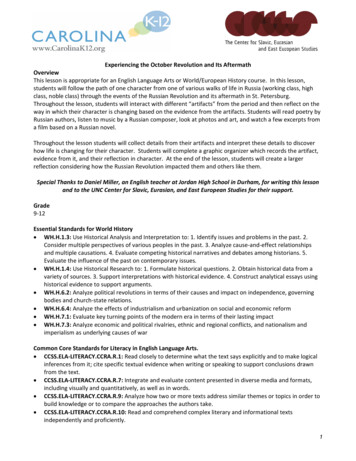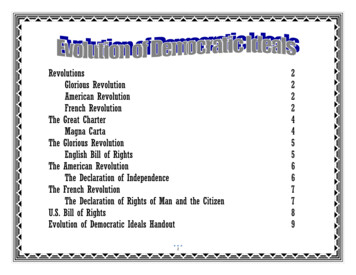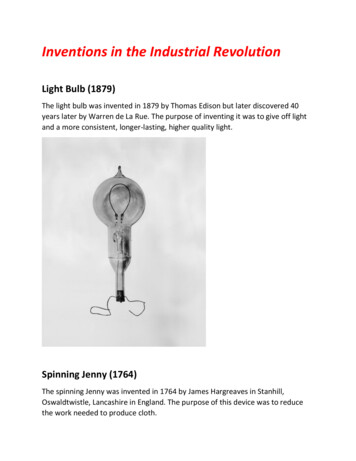
Transcription
Inventions in the Industrial RevolutionLight Bulb (1879)The light bulb was invented in 1879 by Thomas Edison but later discovered 40years later by Warren de La Rue. The purpose of inventing it was to give off lightand a more consistent, longer-lasting, higher quality light.Spinning Jenny (1764)The spinning Jenny was invented in 1764 by James Hargreaves in Stanhill,Oswaldtwistle, Lancashire in England. The purpose of this device was to reducethe work needed to produce cloth.
Steam Engine (1712)The Steam Engine was invented by Thomas Newcomen in 1712. They were usedin factories, mines, locomotives, and steamboats. They take steam from boilingwater and use it to drive a piston(s) back and forth.
Cotton Gin (1794)The Cotton Gin was invented in 1794 by Eli Whitney. The Cotton Gin was used forfast production of cotton by increasing the speed of removing seeds from cottonfiber.
Electrical Telegraph (1830-1840)The Electrical Telegraph was invented sometime during the 1830s-1840s bySamuel Morse. It was made for receiving and sending messages over longdistance.
Power Loom (1785)The Power Loom was invented in 1785 by Edmund Cartwright. It was designed toweave threads into cloth and was steam powered.Flying Shuttle (1733)The Flying Shuttle was invented by John Kay in 1733. Its purpose was to let asingle weaver to weave wider fabrics.
Spinning Mule (1779)The Spinning Mule was invented by Samuel Crompton in 1779. It increased theamount of cotton that could be spun at any one time.
Sewing Machine (1790)The Sewing Machine was invented in 1790 by Thomas Saint. It’s used to sewfabric or other materials with thread.Dynamite (1867)Dynamite was invented in 1867 by Alfred Nobel. It was mainly used to explodemines and rock for materials or industrialization.
How did the Lightbulb evolve over time?Thomas Edison invented the lightbulb in 1879. They lasted longer and werebrighter than lights with carbon filaments. Then later in 1939, fluorescent lightswere introduced to the New York World’s Fair and the Golden Gate Exposition byGE and Westinghouse. LEDS were later invented by Nick Holonyak. 2002-2008was when LED bulbs started making their way into residential homes. Now, from2014-2019, lightbulbs have made a major leap in technology, as we now have LEDstrips, smart light bulbs, and many other more advanced light appliances. Whilethe look of lightbulbs has obviously changed, so has the purpose. Beforelightbulbs were strictly used to light up an area to see, now we use lights asdecoration and entertainment, as well as mandatory use like lamps and icalTelegraph(!830-1840)Dynamite(1867)Light Bulb(1879)
A) I knew the information was reliable because I checked that the same information was onnumerous different sites.B) I chose Word because in my opinion it’s the easiest to work with and understand.C) YesD) I would use my time more wisely and have it planned out more.BibliographyBellis, Mary. “History of the Sewing Machine.” ThoughtCo, ThoughtCo, 7 Jan. ing-machines-1992460.“Crompton's Spinning Mule.” Age of Revolution, ule/.“Dynamite.” Wikipedia, Wikimedia Foundation, 26 Nov. 2019, en.wikipedia.org/wiki/Dynamite.The Editors of Encyclopaedia Britannica. “Flying Shuttle.” Encyclopædia Britannica,Encyclopædia Britannica, Inc., 3 Apr. 2018, y.com Editors. “Cotton Gin and Eli Whitney.” History.com, A&E Television Networks, 4Feb. 2010, li-whitney.History.com Editors. “Morse Code & the Telegraph.” History.com, A&E Television Networks, 9Nov. 2009, ustrial Revolution.” Ducksters Educational Site,www.ducksters.com/history/us 1800s/steam engine industrial revolution.php.Lutz, Bill. “How Light Bulbs Have Changed Over The Years.” Generation 3 Electric & HVAC, 19Dec. 2018, ave-changed-over-theyears/.“Power Loom.” Inventions of the Industrial com/power-loom.html.
Sewing Machine (1790) The Sewing Machine was invented in 1790 by Thomas Saint. It’s used to sew fabric or other materials with thread. Dynamite (1867) Dynamite was invented in 1867 by Alfred Nobel. It was mainly used to e

